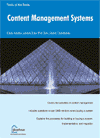Best Practices in Content Management
We discussed several issues surrounding Best Practices in our first print column for EContent magazine in January 2005.
We now see two distinct areas for best practices in content management, in the Content lifecycle and in the CMS lifecycle (the selection and implementation process for a new CMS).
Thus, Making the Business Case for a CMS belongs in the second area, and Metadata Tagging belongs in the first.
We drew up a list of Best Practices areas for use by CM Professionals over a year ago. At that time we mixed together areas that are best separated into Content and CMS lifecycles.
Related Links
CMS WatchCMS Forum
CMS Wiki
CMS Info
CMS News
CMS Lists
Content Wire
Content Manager (Europe)
Google CMS
DMOZ CMS
Metatorial
Step Two
OSCOM
Here is our draft list of important best practice areas in 2004.
Getting Stakeholder Support
Making the Business Case
Assembling the Project Team
Auditing the Content
Aligning Content Strategy to Business Strategy
Building Categories
Controlling Vocabularies
Information Structure
Design for Reuse
Search
Navigation
Visual Design
Use Case Testing
Training the Contributors
Change Management
Content Conversion
Content Migration
Metadata Tagging
Roles-based Workflow
Proof Of Concept
Scalability
Full Deployment
Content Lifecycle
Multichannel Publishing
Performance Metrics
Getting Stakeholder Support
Making the Business Case
Assembling the Project Team
Auditing the Content
Aligning Content Strategy to Business Strategy
Building Categories
Controlling Vocabularies
Information Structure
Design for Reuse
Search
Navigation
Visual Design
Use Case Testing
Training the Contributors
Change Management
Content Conversion
Content Migration
Metadata Tagging
Roles-based Workflow
Proof Of Concept
Scalability
Full Deployment
Content Lifecycle
Multichannel Publishing
Performance Metrics
You will see these are primarily of interest for the CMS lifecycle, and we arranged them from beginning to end of the CMS lifecycle, but many of them apply equally to the Content lifecycle, like Roles-based Workflow.
The CMS lifecycle is concerned with difficult business issues like return on investment, getting stakeholder support, making the business case, assembling the project team, requests for proposals, vendor selection, and content conversion and migration.
Content lifecycle issues controlling vocabularies, information architecture, navigation design, search, metadata tagging, roles-based workflow, and designing for reuse.
Practices in both lifecycles include auditing content and aligning content strategy to business strategy.
Design Patterns for Best Practices
We are proposing that these various practices be arranged formally using a Design Pattern Library. Design Patterns lend themselves well to structured authoring. To reference other patterns in the library, it is helpful to assign pattern numbers. And better still, we should have major and minor numbers to identify practices. For example, 1.1 Business Strategy and 1.4 Vocabulary Control.
For the CMS Lifecycle, we identified fifteen steps to research and select a CMS. We are developing additional steps for implementation.
Step 1. Organize ContentStep 2. Search The Web
Step 3. Books and Articles
Step 4. Vendor-neutral Consultants
Step 5. Magazines
Step 6. Industry Analyst Reports
Step 7. Trade Shows
Step 8. Vendors
Step 9. Vendor-specific Consultants
Step 10. Needs Analysis/Specifications Document and Request for Proposals
Step 11. Demonstration Systems
Step 12. First cut of CMS's
Step 13. Prototype Sites with Your Content
Step 14. Timetables and Milestone Agreements
Step 15. Final Selection
We propose to divide the Content Lifecycle into seven stages, and will divide the practices and their design patterns into these seven major groups.
Stage 1. OrganizationStage 2. Workflow
Stage 3. Creation
Stage 4. Repository
Stage 5. Versioning
Stage 6. Publishing
Stage 7. Archives








